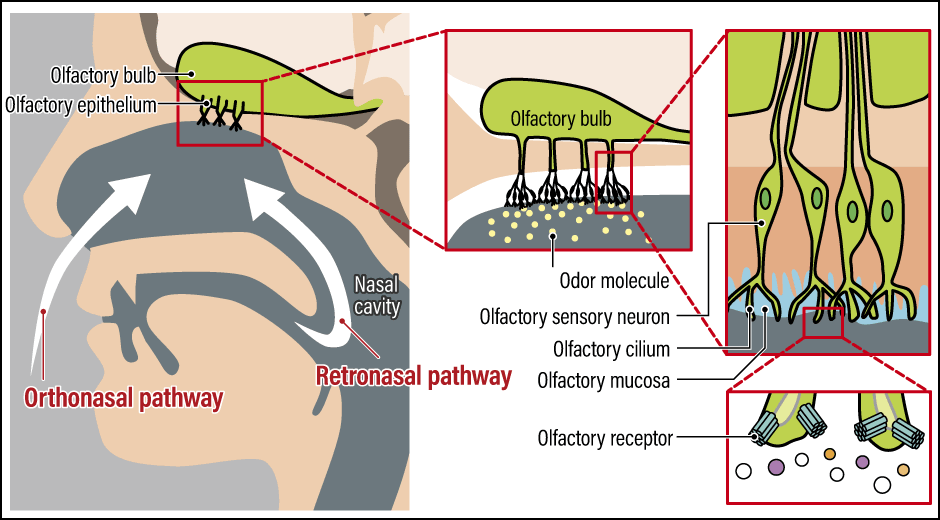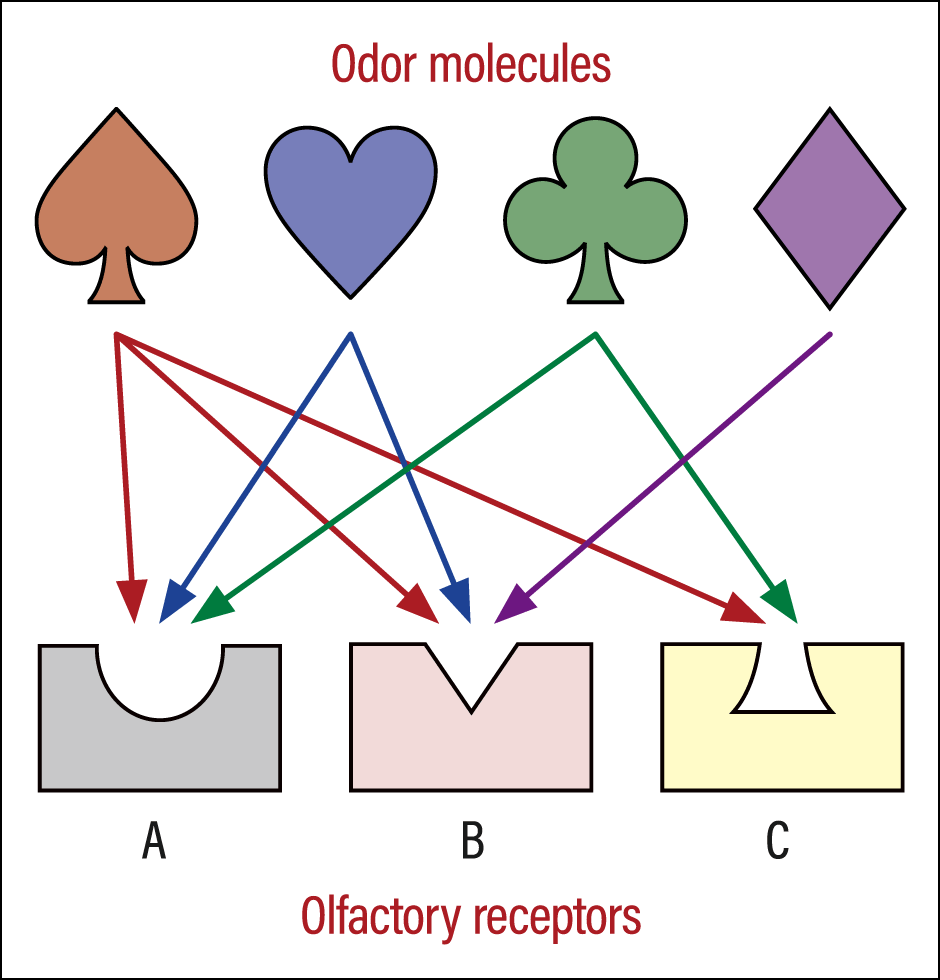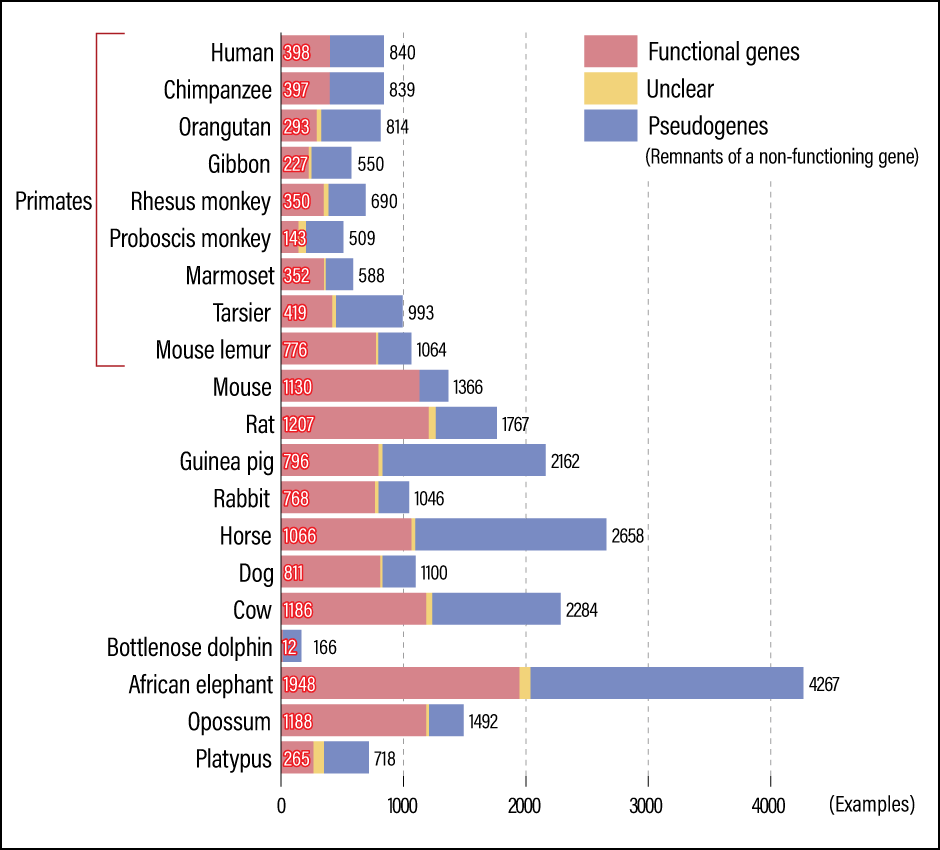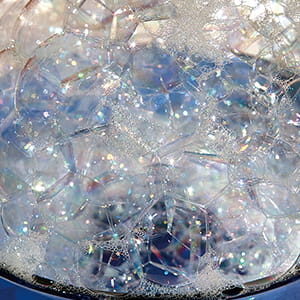Mammals’ sense of smell is the oldest of the five senses and evolved in response to the environment. This sense is crucial to survival, protecting mammals against natural predators and helping them to avoid things that have gone rotten. For humans, olfaction also enables us to enjoy what we eat. It has been posited that humans’ sense of smell exhibits a synergistic effect, in which the brain develops in order to obtain better food, with the pursuit of tastier food then resulting in the brain growing in size. Having evolved in this specific way in humans, olfaction might hold the key to unlocking the mystery of human evolution.
Special Feature 1 – The Science of Smell Olfaction enabling us to savor tasty flavors could hold the key to solving the mystery of human evolution!
composition by Rie Iizuka
illustration by Koji Kominato
What is a smell?
The smells that we humans sense basically come from volatile molecules wafting through the air. When these molecules bind to our olfactory receptors, the information is conveyed to the brain and they are sensed as smells. In other words, it is the receptors that make them smells, while the molecules themselves do not have a smell. Given this fact, the molecules that bind to receptors and are perceived as smells are referred to here as odor molecules.
The nose has around 5 million olfactory sensory neurons
Most odor molecules are organic compounds composed of carbon, oxygen, hydrogen, nitrogen, and sulfur. However, there is believed to be no general principle governing the forms and bonds of the molecules that give rise to smells. While we can at least predict that a molecule containing sulfur is likely to smell unpleasant and that many esters have a fruity smell, such rules of thumb do not apply to quite a few molecules. This may well be related to a key characteristic of olfactory receptors, in that there are very many different kinds of olfactory receptors and one receptor will bind with multiple molecules.
First, let me explain the mechanism of smell (Figure 1).

Figure 1. The mechanism of smellOdor molecules reach the olfactory receptors located in the olfactory epithelium on the roof of the nasal cavity. The pathway through which molecules floating in the air enter the nose when breathing, etc. and reach the olfactory epithelium is called the orthonasal pathway, while the pathway via which odor molecules that have risen up from the throat when swallowing food are perceived is called the retronasal pathway.
The olfactory epithelium in the nose has approximately 5 million olfactory sensory neurons covered by olfactory mucosa, with whisker-like olfactory cilia growing from these neurons. The olfactory receptors are found on the surface of the olfactory cilia, and when an odor molecule binds to one of these receptors, the information is transmitted from the olfactory sensory neuron to a region of the brain called the olfactory bulb. Positioned immediately above the olfactory epithelium, the olfactory bulb is the place where information about smells is integrated. It is believed that this information is then relayed to areas called the olfactory cortex and the orbitofrontal cortex, where they are perceived as smells and trigger emotions or physiological responses. However, we still do not have a good understanding of the mechanism by which this information is processed in the brain.
Humans also have something called the retronasal pathway for smells. Odor molecules generated by foods reach the olfactory epithelium via the back of the throat. You probably know from experience that these smells substantially affect how food tastes.
The complexity of olfaction stems, first and foremost, from the many different types of receptors, as touched upon above. Humans have around 400 types of olfactory receptors. Given that we have only three types of photoreceptors for seeing colors, one can imagine the complexity of the sense of smell.
There are about 5 million olfactory sensory neurons, each of which expresses one of the approximately 400 types of receptors. This means that, on average, there are somewhere around 10,000 cells expressing the same receptor. These cells are randomly positioned in the olfactory epithelium.
In addition, olfactory receptors have features that make them differ slightly from other receptors. For example, a hormone and the receptor that binds to it have a one-to-one correspondence, so if there is even a slight mismatch between them, they will not bind and therefore will not act. However, olfactory receptors have a many-to-many relationship, enabling a single type of receptor to bind to a variety of odor molecules. In fact, olfactory receptors are believed to perceive part of odor molecules (Figure 2).

Figure 2. Combinational codeCapable of recognizing the round part of an odor molecule, receptor A binds to and activates the club, heart, and spade, but does not bind to the diamond. Receptor B binds with and activates odor molecules other than the club. Thus, there are diverse patterns of activation.
Skatole becoming a floral scent at lower concentration levels
Generally speaking, receptors are designed to be highly specific, but it is likely that olfactory receptors came to form loose bonds because they cannot predict what kind of odor molecules will reach them. It is thought that the body developed the ability to distinguish between the countless different odor molecules by altering the number of receptors and their activation patterns.
For example, a single cup of coffee is estimated to contain around 300 different flavor components and we are able to enjoy the distinctive aroma of coffee produced by their harmony. In some cases, we also experience odor molecules in totally different ways, depending on their concentration.
A molecule called skatole is responsible for the unpleasant odor given off by mammalian feces, but as its concentration declines, it turns into a sweet floral scent. For example, the scent of jasmine flowers contains a low concentration of skatole. Thus, the sense of smell perceives the same odor molecule as different information simply because the concentration differs.
Looking at the other senses, too, perceptions of bitterness by our sense of taste, for example, differ quite considerably. Humans have 25 different kinds of bitterness receptors, but they are expressed in a single cell. Even if, logically speaking, it were possible to distinguish between 25 types of bitterness based on the number of types of receptors, the brain does not distinguish between types of bitterness. The system is such that it simply needs to judge whether or not something is toxic.
It is believed that humans do not innately understand the meanings of smells. The sense of taste differs in this regard. A newborn infant will screw up its face in disgust if a bitter-tasting compound is placed on its tongue, but will look happy if given a sweet-tasting one. Humans are genetically programmed to identify toxins and nutrients. In the case of olfaction, when a mouse smells the odor of a fox or other predator, it will enter a state referred to as freezing, in which its body goes rigid, even if it has never smelled that odor before. This is because the odor means a predator is nearby, so the mouse should not move.
However, there are no odor molecules that humans are innately programmed to like or dislike. It is believed that we learn whether a smell is pleasing or should be avoided, because the meaning of a smell varies according to our living environment. As receptors are located on the outermost parts of the body and their role is to sense the outside world, it is entirely logical that they should change in response to our environment.
An effective means of unraveling human evolution
The human olfactory bulb —— the region that controls smell information —— is located some distance from the cerebral neocortex. In fact, the olfactory bulb is separated from and independent of the main brain not only in humans, but also in all animals. Found in fish as well, the olfactory bulb is a primitive region preserved in all vertebrates. Here, the word “primitive” means something present for a long time, with ancient evolutionary origins. As each type of organism has evolved, the significance of olfaction has come to differ.
An extreme example is found in dolphins, which do not have an olfactory bulb to process information about smells. They have also lost almost all their olfactory receptor genes in the process of evolution. Instead, dolphins have acquired the ability of echolocation, enabling them to measure the size of an object or the distance to it by emitting sound waves from a mass of adipose tissue called the melon. Thus, they have evolved in a manner reliant on their sense of hearing.
In other words, shedding light on the evolution of the sense of smell, which is a function that has existed since ancient times, could by the same token become an effective means of unraveling the secrets of human evolution itself.
We are investigating olfactory receptor genes by analyzing the genome sequences of various animals. Our research to date has revealed that the mammals with the largest number of olfactory receptor genes are African elephants (Figure 3).

Figure 3. Number of olfactory receptor genes in mammalsUnexpectedly, the African elephant has the largest number of olfactory receptor genes, while humans also have quite a few more than had been thought.
Having a large number of genes means that there are many types of receptors. Elephants certainly do appear to use their olfaction to obtain information about the outside world and actually communicate with each other via smell to a great extent. So, do African elephants have a much better sense of smell than dogs or humans?
When talking about having an acute sense of smell, we must not forget that this encompasses two meanings: the ability to detect even faint smells, and the ability to distinguish between numerous different types of smell. As olfactory receptors have a many-to-many relationship, the fact that there are numerous types of receptors means we can presume that these elephants have a high level of ability to tell smells apart.
On the other hand, while dogs only have around 800 olfactory receptor genes, they are believed to have approximately 200 million olfactory sensory neurons, as against about 5 million in humans. Even if there are not all that many types of receptors, the sheer number of neurons means dogs can detect even a small number of odor molecules.
Thus, it would be fair to say that olfaction is a function that has evolved flexibly in forms suited to each animal’s environment, developing greater sensitivity to certain smells, or extending the range of smells that can be detected, or being abandoned altogether.
On reflection, I think that, even in humans today, the sense of smell is what makes us human. My argument here is a little circuitous, but I would like to start by explaining the gene duplication of olfactory receptors.
Humans have as many as 400 olfactory receptor genes, but the precise number varies from one individual to another, as do the genes they carry. Olfactory receptor genes are known to demonstrate considerable individual variation, even when compared to other genes.
There was originally just one olfactory receptor gene, but they fluctuated in number over the process of evolution, eventually reaching around 400 in humans. First of all, let me explain about increases in the number of genes.
When cells divide, a copy of their DNA (chromosomes) is produced, but errors in which two copies of the same place are made by mistake occur with surprising frequency. If this happens to occur in a region of the chromosome carrying a gene, it will result in the production of two genes, where the original chromosome had only one.
However, this alone does not mean that the number of genes in that species has increased. While gene duplication also occurs in genes other than olfactory receptor genes, it is a very rare phenomenon in those other genes. This is because genes are not merely stored in the genome; the instructions concerning how their expression is regulated, and which proteins they will produce in which quantities, when and in which cells are written in some other location on the genome. Accordingly, if a particular gene has doubled, the portion that regulates its expression also needs to double, but if this occurs, double the amount of protein will be produced. As this situation could be problematic if it occurred frequently, it is rarely the case that a duplication error results in its being shared throughout the population.
However, in the case of olfactory receptors, one cell expresses only one type of receptor, so having several genes in the genome will not pose a problem, making it easier for the organism to tolerate an increase in the number of genes.
Furthermore, while there is no advantage to the organism in having two of exactly the same gene, a spontaneous mutation occurring in the extra gene will, in the case of an olfactory receptor gene, alter the odor molecules with which it can bind, thereby leading to an increase in the types of olfactory receptors. Whereas this is not helpful in the case of hormone receptors, as there are no molecules with which they can bind, the many-to-many relationship of olfactory receptors means they simply acquire a new function, in the form of the ability to identify smells that they could not previously identify.
All genes are also subject to the phenomenon of decreases. Moreover, if the result of losing the function for which that gene was responsible is detrimental to the organism’s survival, the individual concerned will be unable to survive and that gene will therefore not spread throughout the population. However, the loss of an olfactory receptor gene has little impact, because the receptors have a many-to-many relationship.
Rapid turnover of olfactory receptor genes
The turnover (replacement) of olfactory receptor genes takes place at a much more intense pace than seen among the genes for other receptors. In fact, fluctuations involving several hundred genes have occurred in the process of mammalian evolution, so even though the number might appear to be the same, the nature of those genes differs completely.
In contrast, the repertoire of taste receptor genes has not varied all that much across all mammals; mice have 36 different types of bitterness receptors, which is more than humans, but we share many of them. This seems reasonable when you think that bitterness is a universal function for sensing toxins. And looking at changes in olfactory receptor genes inevitably means looking at the evolutionary process of that species to find out what smells it needed to detect as part of its dependence on its living environment.
So, in humans, similarly, looking at changes in olfactory receptor genes could well provide clues for us to find out what makes us human and what it means to be human.
Humans are said to gain a vast amount of information via our sense of sight, but humans and chimpanzees have the same number of visual receptors, and the light wavelengths to which they respond are more or less the same. Accordingly, while there are differences in the ways in which the information is processed in the brain, the world as viewed by humans should not differ all that much from the world viewed by chimpanzees. However, the same cannot be said for our senses of smell. Even though the chimpanzee genome is said to be 98% similar to the human genome, chimpanzees share only about 75% of olfactory receptor genes with humans, at around 300 of our 400 genes. I believe that finding out which receptors have evolved specifically in humans will provide us with the key to unraveling our evolution into humans.
Second, our enjoyment of what we eat has tremendous significance for humans in the course of our lives. This is a characteristic not found in other animals. It is thanks to the retronasal pathway for smells. Retronasal olfaction is basically only found in humans. At the very least, it does not exist in dogs or mice.
The reason why we can enjoy the flavor of coffee even though we can sense only one type of bitterness is that the 300 or so flavor components in coffee stimulate our olfaction. In addition, humans developed the ability to use fire to cook food, which generated smells that stimulate the appetite.
The sense of smell has come to take on huge meaning for humans as a means of choice, to obtain tastier food, rather than for the purpose of survival, including fleeing from natural predators. Brain development is also required to choose better food and there may be a positive feedback effect in which energy efficiency improves, causing the brain to develop synergistically, which in turn enables the individual to obtain even better food, and thus the brain increases in size.
While some people say olfaction is not important for humans, I believe that it is actually of even greater importance in humans than in other creatures. I hope to continue striving to shed light on how humans became humans through the prism of our sense of smell.


















